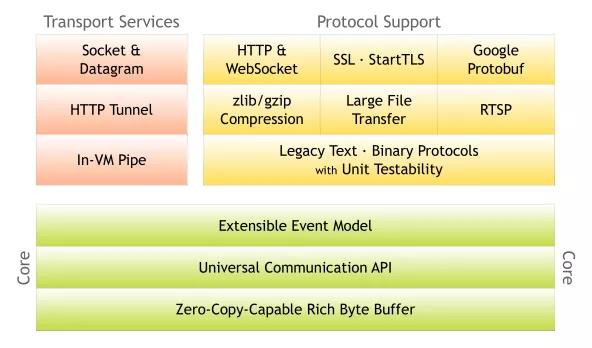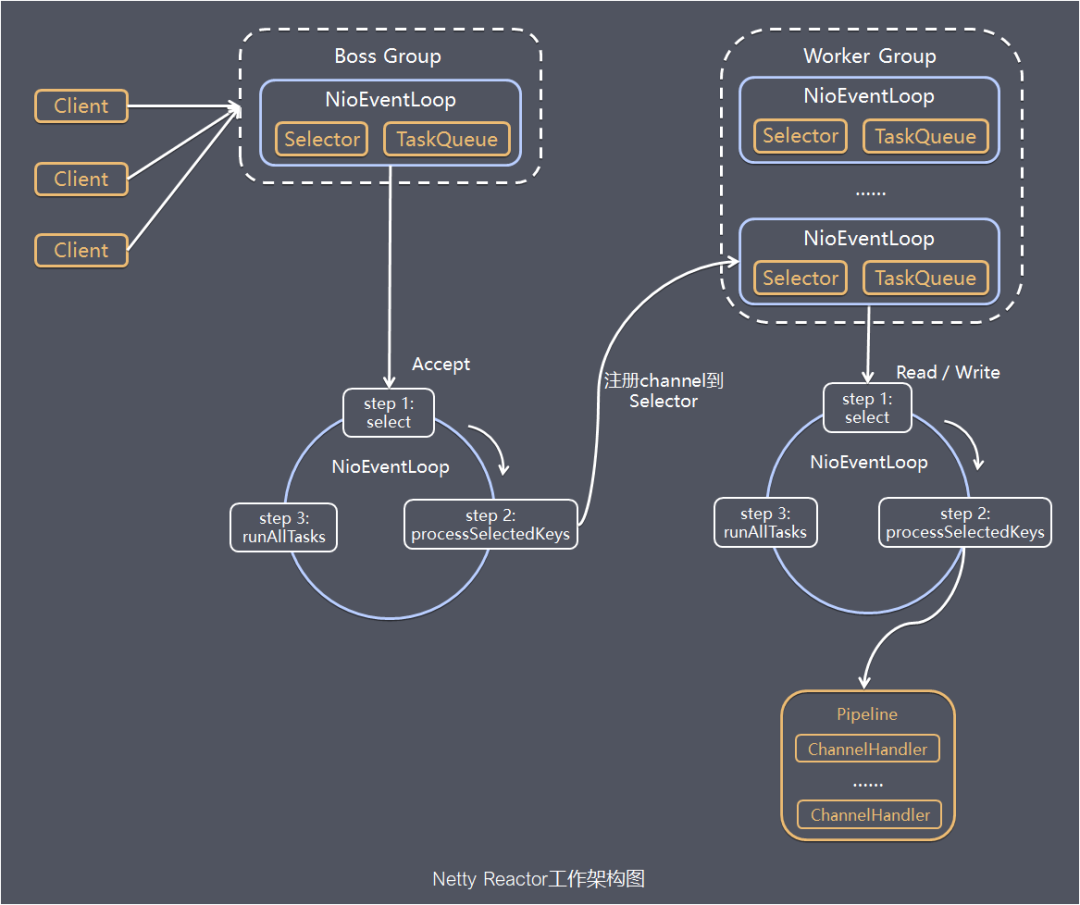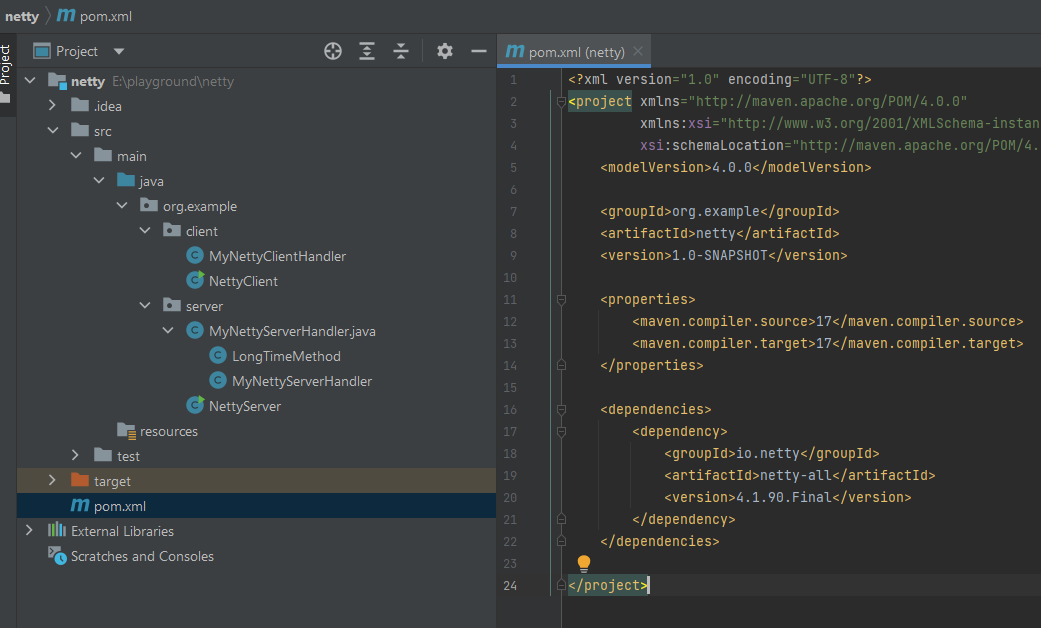一、为什么使用Netty
1. NIO的缺点
- NIO的类库和API繁杂,学习成本高,你需要熟练掌握Selector、ServerSocketChannel、SocketChannel、ByteBuffer等。
- 需要熟悉Java多线程编程。这是因为NIO编程涉及到Reactor模式,你必须对多线程和网络编程非常熟悉,才能写出高质量的NIO程序。
- 臭名昭著的epoll bug。它会导致Selector空轮询,最终导致CPU 100%。直到JDK1.7版本依然没得到根本性的解决。
2. Netty的优点
- API使用简单,学习成本低。
- 功能强大,内置了多种解码编码器,支持多种协议。
- 性能高,对比其他主流的NIO框架,Netty的性能最优。
- 社区活跃,发现BUG会及时修复,迭代版本周期短,不断加入新的功能。
- Dubbo、Elasticsearch都采用了Netty,质量得到验证。
二、Netty架构图

上面这张图就是在官网首页的架构图,我们从上到下分析一下。
- 绿色的部分Core核心模块,包括零拷贝、API库、可扩展的事件模型。
- 橙色部分Protocol Support协议支持,包括Http协议、webSocket、SSL(安全套接字协议)、谷歌Protobuf协议、zlib/gzip压缩与解压缩、Large File Transfer大文件传输等等。
- 红色的部分Transport Services传输服务,包括Socket、Datagram、Http Tunnel等等。
以上可看出Netty的功能、协议、传输方式都比较全,比较强大。
三、搭建 Hello World
首先搭建一个HelloWord工程,先熟悉一下API,还有为后面的学习做铺垫。
以下面这张图为依据:

0. 项目结构概览

1. 引入Maven依赖
<dependency>
<groupId>io.netty</groupId>
<artifactId>netty-all</artifactId>
<version>4.1.90.Final</version>
</dependency>
2. 创建服务端启动类
package org.example.server;
import io.netty.bootstrap.ServerBootstrap;
import io.netty.channel.ChannelFuture;
import io.netty.channel.ChannelInitializer;
import io.netty.channel.ChannelOption;
import io.netty.channel.EventLoopGroup;
import io.netty.channel.nio.NioEventLoopGroup;
import io.netty.channel.socket.SocketChannel;
import io.netty.channel.socket.nio.NioServerSocketChannel;
public class NettyServer {
public static void main(String[] args) {
NettyServer server = new NettyServer();
server.start();
}
public void start() {
//创建两个线程组 boosGroup、workerGroup
EventLoopGroup bossGroup = new NioEventLoopGroup();
EventLoopGroup workerGroup = new NioEventLoopGroup();
try {
//创建服务端的启动对象,设置参数
ServerBootstrap bootstrap = new ServerBootstrap();
//设置两个线程组boosGroup和workerGroup
bootstrap.group(bossGroup, workerGroup)
//设置服务端通道实现类型
.channel(NioServerSocketChannel.class)
//设置线程队列得到连接个数
.option(ChannelOption.SO_BACKLOG, 128)
//设置保持活动连接状态
.childOption(ChannelOption.SO_KEEPALIVE, true)
//使用匿名内部类的形式初始化通道对象
.childHandler(new ChannelInitializer<SocketChannel>() {
@Override
protected void initChannel(SocketChannel socketChannel) throws Exception {
//给pipeline管道设置处理器
socketChannel.pipeline().addLast(new MyNettyServerHandler());
}
});//给workerGroup的EventLoop对应的管道设置处理器
System.out.println("java技术爱好者的服务端已经准备就绪...");
//绑定端口号,启动服务端
ChannelFuture channelFuture = bootstrap.bind(6666).sync();
//对关闭通道进行监听
channelFuture.channel().closeFuture().sync();
} catch (InterruptedException e) {
e.printStackTrace();
} finally {
bossGroup.shutdownGracefully();
workerGroup.shutdownGracefully();
}
}
}
3. 创建服务端处理类
package org.example.server;
import io.netty.buffer.ByteBuf;
import io.netty.buffer.Unpooled;
import io.netty.channel.ChannelHandlerContext;
import io.netty.channel.ChannelInboundHandlerAdapter;
import io.netty.util.CharsetUtil;
import java.util.concurrent.TimeUnit;
/**
* 自定义的Handler需要继承Netty规定好的HandlerAdapter
* 才能被Netty框架所关联,有点类似SpringMVC的适配器模式
**/
public class MyNettyServerHandler extends ChannelInboundHandlerAdapter {
@Override
public void channelRead(ChannelHandlerContext ctx, Object msg) throws Exception {
//获取客户端发送过来的消息
ByteBuf byteBuf = (ByteBuf) msg;
String strMsg = byteBuf.toString(CharsetUtil.UTF_8);
System.out.println("收到客户端" + ctx.channel().remoteAddress() + "发送的消息:" + strMsg);
/*
* 如果Handler处理器有一些长时间的业务处理,可以交给taskQueue异步处理。
*/
// 长时间操作,不至于长时间的业务操作导致Handler阻塞。
ctx.channel().eventLoop().execute(new LongTimeMethod(strMsg));
// 延时任务队列和上面介绍的任务队列非常相似,只是多了一个可延迟一定时间再执行的设置
ctx.channel().eventLoop().schedule(new LongTimeMethod(strMsg), 5, TimeUnit.SECONDS);
}
@Override
public void channelReadComplete(ChannelHandlerContext ctx) throws Exception {
//发送消息给客户端
ctx.writeAndFlush(Unpooled.copiedBuffer("服务端已收到消息,并给你发送一个信号。", CharsetUtil.UTF_8));
}
@Override
public void exceptionCaught(ChannelHandlerContext ctx, Throwable cause) throws Exception {
//发生异常,关闭通道
ctx.close();
}
}
class LongTimeMethod implements Runnable{
private String message;
public LongTimeMethod (String message) {
this.message = message;
}
@Override
public void run() {
try {
Thread.sleep(5000);
System.out.println("长时间的业务处理: " + message);
} catch (InterruptedException e) {
e.printStackTrace();
}
}
}
4. 创建客户端启动类
package org.example.client;
import io.netty.bootstrap.Bootstrap;
import io.netty.channel.ChannelFuture;
import io.netty.channel.ChannelFutureListener;
import io.netty.channel.ChannelInitializer;
import io.netty.channel.nio.NioEventLoopGroup;
import io.netty.channel.socket.SocketChannel;
import io.netty.channel.socket.nio.NioSocketChannel;
public class NettyClient {
public static void main(String[] args) throws Exception {
NettyClient client = new NettyClient();
client.start();
}
public void start() {
NioEventLoopGroup eventExecutors = new NioEventLoopGroup();
try {
//创建bootstrap对象,配置参数
Bootstrap bootstrap = new Bootstrap();
//设置线程组
bootstrap.group(eventExecutors)
//设置客户端的通道实现类型
.channel(NioSocketChannel.class)
//使用匿名内部类初始化通道
.handler(new ChannelInitializer<SocketChannel>() {
@Override
protected void initChannel(SocketChannel channel) throws Exception {
//添加客户端通道的处理器
channel.pipeline().addLast(new MyNettyClientHandler());
}
});
System.out.println("客户端准备就绪,随时可以起飞~");
//连接服务端
ChannelFuture channelFuture = bootstrap.connect("127.0.0.1", 6666).sync();
this.addFutureListener(channelFuture);
//对通道关闭进行监听
channelFuture.channel().closeFuture().sync();
} catch (InterruptedException e) {
e.printStackTrace();
} finally {
//关闭线程组
eventExecutors.shutdownGracefully();
}
}
private void addFutureListener (ChannelFuture future) {
//添加监听器
future.addListener(new ChannelFutureListener() {
//使用匿名内部类,ChannelFutureListener接口
//重写operationComplete方法
@Override
public void operationComplete(ChannelFuture future) throws Exception {
//判断是否操作成功
if (future.isSuccess()) {
System.out.println("连接成功");
} else {
System.out.println("连接失败");
}
}
});
}
}
5. 创建客户端处理类
package org.example.client;
import io.netty.buffer.ByteBuf;
import io.netty.buffer.Unpooled;
import io.netty.channel.ChannelHandlerContext;
import io.netty.channel.ChannelInboundHandlerAdapter;
import io.netty.util.CharsetUtil;
public class MyNettyClientHandler extends ChannelInboundHandlerAdapter {
@Override
public void channelActive(ChannelHandlerContext ctx) throws Exception {
//发送消息到服务端
String msg = "歪比巴卜~茉莉~Are you good~马来西亚~";
System.out.println("给服务端发送信息:" + msg);
ctx.writeAndFlush(Unpooled.copiedBuffer(msg, CharsetUtil.UTF_8));
}
@Override
public void channelRead(ChannelHandlerContext ctx, Object msg) throws Exception {
//接收服务端发送过来的消息
ByteBuf byteBuf = (ByteBuf) msg;
String strMsg = byteBuf.toString(CharsetUtil.UTF_8);
System.out.println("收到服务端" + ctx.channel().remoteAddress() + "的消息:" + strMsg);
}
}
6. 测试
先启动服务端,再启动客户端,就可以看到结果:
服务端结果:
# java技术爱好者的服务端已经准备就绪...
# 收到客户端/127.0.0.1:11972发送的消息:歪比巴卜~茉莉~Are you good~马来西亚~
# 长时间的业务处理: 歪比巴卜~茉莉~Are you good~马来西亚~
# 长时间的业务处理: 歪比巴卜~茉莉~Are you good~马来西亚~
客户端结果:
# 客户端准备就绪,随时可以起飞~
# 给服务端发送信息:歪比巴卜~茉莉~Are you good~马来西亚~
# 连接成功
# 收到服务端/127.0.0.1:6666的消息:服务端已收到消息,并给你发送一个信号。
Ref